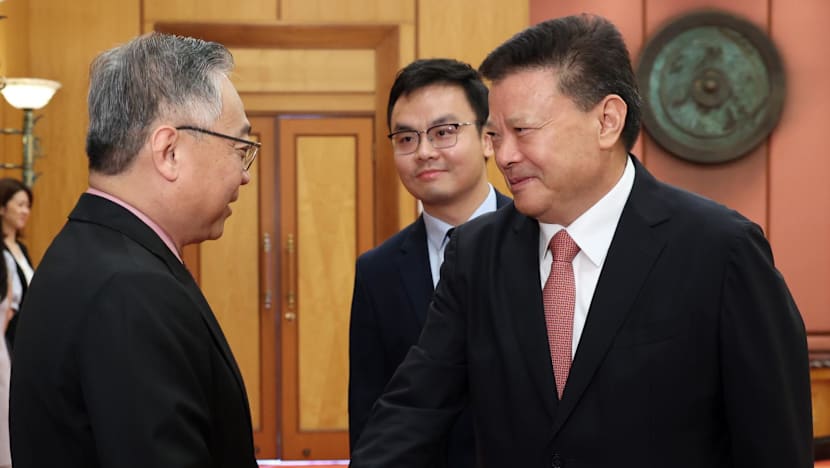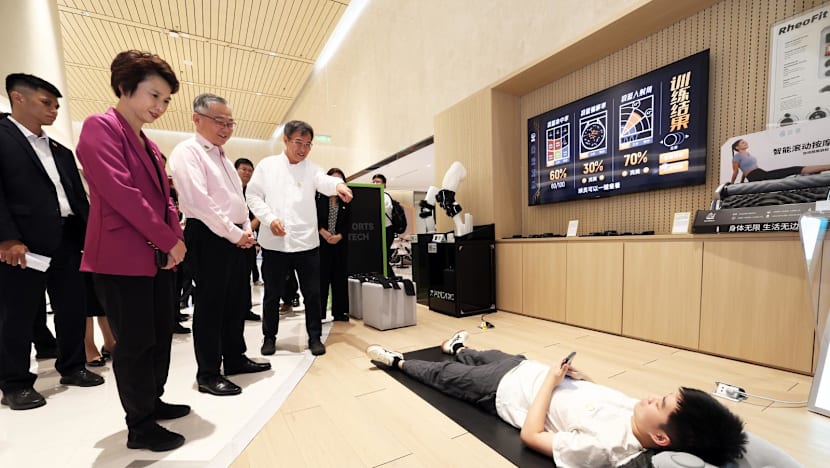Singapore, Shenzhen can form gateway linking Greater Bay Area and Southeast Asia: DPM Gan
Both sides are connected through economic “triangles” - Guangzhou-Shenzhen-Hong Kong, and Singapore-Johor-Batam, he told Shenzhen party chief in a meeting on Tuesday (Sep 2).

Deputy Prime Minister Gan Kim Yong shakes hands with “Youyou”, a panda-themed bipedal robot from UBTech, during his visit to the Shenzhen firm on Sep 2. (Photo: Ministry of Digital Development and Information)

This audio is generated by an AI tool.
SHENZHEN: Singapore and Shenzhen can join forces to become a gateway connecting the Greater Bay Area and Southeast Asia, said Deputy Prime Minister Gan Kim Yong on a working visit to China.
Mr Gan met Shenzhen party secretary Meng Fanli on Tuesday (Sep 2) morning at the Wuzhou Guest House in Shenzhen.
Mr Gan noted that Guangdong is one of Singapore’s key provincial trading partners in China, and that Shenzhen accounts for about 40 per cent of Singapore’s trade volume with the province.
He added that Singaporean companies remain keen to invest in Shenzhen.
“We recognise that currently the economy in China is facing significant headwinds, but I believe in the underlying long-term potential of the Chinese economy. We continue to have interest in investing in China and in Shenzhen,” Mr Gan said.
Singapore and Shenzhen will seek to deepen cooperation in artificial intelligence (AI), the digital and green economies, supply chains, healthcare, sports, tourism, and cultural exchanges.

Mr Gan underscored Shenzhen’s role as a gateway to the Greater Bay Area and Singapore’s as a gateway to Southeast Asia.
Both sides, he said, are connected through economic “triangles” - Guangzhou-Shenzhen-Hong Kong, and Singapore-Johor-Batam, referring to the SIJORI growth triangle.
“I think it will be very interesting for Singapore and Shenzhen to work together and become a gateway between the Greater Bay Area and the growth triangle of Singapore.”
The Singapore-Johor-Riau (SIJORI) growth triangle, first announced in 1989 by then-Deputy Prime Minister Goh Chok Tong, was conceived as a partnership that combined Singapore’s financial and infrastructure strengths with Johor’s land and labour resources, and Batam’s affordability and space to attract regional investment.
Mr Gan encouraged Shenzhen businesses to consider manufacturing in Johor, sourcing raw materials from Batam, and using Singapore as a logistics and headquarters hub, calling it “a win-win proposition”.
Both leaders also reaffirmed their commitment to the Singapore-Shenzhen Smart City Initiative (SCI).
Launched in 2019, the SCI serves as a platform for joint projects in digital connectivity, innovation, low-carbon solutions and smart healthcare, and includes a demonstration zone in Shenzhen.
Mr Meng said the SCI has already created a strong foundation, and there is scope to expand cooperation into broader areas such as AI and the digital economy.
“This is a field that is changing rapidly, and we hope to further strengthen exchanges and cooperation in a wider range of areas,” he said.

He added that both sides could deepen two-way trade, investment, cultural and tourism exchanges, as well as cooperation in science and technology, urban construction and city management.
“We have actually benefited a lot and learned from your good practices through different channels, including from books and also from the internet,” Mr Meng added.
Both leaders also underlined the importance of strengthening people-to-people ties.
Mr Gan met nearly 200 Singaporeans at a reception dinner on Monday, including students on job exchanges in Shenzhen. He described such exchanges as “a very valuable opportunity to strengthen people-to-people ties”.
Mr Meng noted that over the past three years, the largest source of foreign visitors to Shenzhen shifted from Malaysia in 2023, to the US last year, and to Singapore this year.
They agreed to further expand tourism flows, student and entrepreneur exchanges, and cultural cooperation.
Mr Gan is on a working trip to China from Aug 31 to Sep 4, with stops in Guangzhou, Shenzhen and Beijing.
He last visited China in 2023 - first in March as part of then-Prime Minister Lee Hsien Loong's delegation, and then in December as part of then-Deputy Prime Minister Lawrence Wong's delegation.

















